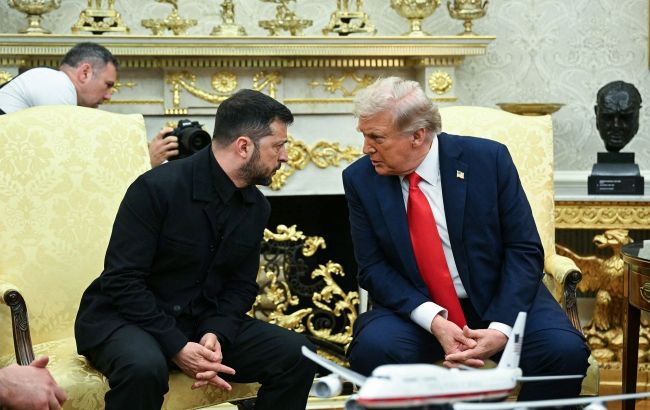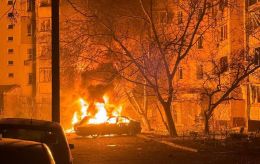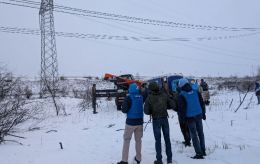Zelenskyy in Washington, Putin hesitates: Highlights from peace talks week
 Volodymyr Zelenskyy and Donald Trump (photo: Getty Images)
Volodymyr Zelenskyy and Donald Trump (photo: Getty Images)
The major summit in Washington, attended by the presidents of Ukraine and the US and European leaders, was the main diplomatic event of the week. Despite the generally positive results, the prospects for ending the war remain extremely unclear.
RBC-Ukraine reports on the main agreements reached this week and plans for the foreseeable future.
Key questions:
- What was the outcome of the meeting between Zelenskyy and Trump?
- What role did territorial issues play in the negotiations?
- What security guarantees are being promised to Ukraine?
- How is the meeting with Putin being prepared?
The main event of the week was the meeting between Ukrainian President Volodymyr Zelenskyy and many European leaders with their counterpart, Donald Trump, in Washington. This impromptu summit took place just days after Trump's talks with Putin in Alaska.
On August 18, Volodymyr Zelenskyy arrived in Washington, where he met with Donald Trump at the White House. Later, collective talks were held between Zelenskyy, Trump, and European leaders. After that, Trump also had a telephone conversation with Putin.
On the eve of Zelenskyy's arrival in the US, many recalled their last meeting in the Oval Office in February, which ended in a loud argument and ultimately led to the cancellation of the visit. However, this time there was no conflict.
Trump once again avoided unequivocally supporting either side, stating that he sympathizes with both Ukrainians and Russians. At the same time, he promised Ukraine very good protection, but noted that a ceasefire as such is not necessary — a major peace agreement is needed immediately. Zelenskyy, on the other hand, tried not to focus on potentially controversial issues, such as territorial concessions.
According to the Financial Times, Ukraine's proposals and conditions for further negotiations were presented during the meetings.
The agency reports that, according to them, Ukraine will not agree to any deal, including territorial concessions to Russia, and insists on a ceasefire.
Kyiv also rejects Russia's proposal to freeze the rest of the front line if Ukrainian troops withdraw from the partially occupied Donetsk and Luhansk regions.
In addition, the Ukrainian side insists on full compensation from Russia for damages, which could potentially be paid from the $300 billion in Russian sovereign assets frozen in Western countries.
Any easing of sanctions should be conditional on Russia's compliance with a future peace agreement and its adherence to fair play.
Despite its scale, this improvised summit turned out to be more of a synchronization of watches. Further negotiations are continuing at a lower level and concern several areas.
Territories
After meeting with Trump, Zelenskyy said that he had a fairly long conversation on the issue of territories. In particular, the situation was analyzed directly on a map prepared by the US, while the Ukrainian side also had its own similar map.
As Zelenskyy explained, such a visual analysis of the situation is necessary for Trump and his team to understand the real pace of the Russian advance on the ground. In summary, Zelenskyy stated that the issue of territories would be discussed personally between him and Putin.
As reported by the Wall Street Journal, Zelenskyy did not reject the idea of a possible exchange of territories during negotiations with Trump. However, according to RBC-Ukraine, this is not true.
Later, during a conversation with journalists, Zelenskyy clarified that before talking about what Ukraine is ready for, it is necessary to find out what Moscow is ready for. Therefore, the territorial issue can only be discussed in detail at his meeting with Putin.
Security guarantees
During the meeting in Washington, the US offered Ukraine an analogue of NATO Article 5 as a security guarantee, but without joining the Alliance.
The author of the idea is Italian Prime Minister Giorgia Meloni, who is promoting the concept of a so-called NATO-light, Bloomberg explains. This model is significantly weaker than the collective guarantees of the Alliance enshrined in Article 5 of the NATO Charter. However, the concept provides that countries that have signed the relevant agreement with Ukraine will quickly coordinate their actions in the event of aggression.
Allies will be able to quickly provide Ukraine with defense support, economic assistance, and impose sanctions against Russia. However, it remains unclear whether such plans include sending European troops to Ukraine. According to Bloomberg sources, negotiations are ongoing, and the content of the proposals may still be changed.
According to sources at the Wall Street Journal, future security guarantees for Ukraine will include four key components: military presence, air defense systems, arms supplies, and mechanisms for monitoring the cessation of hostilities.
According to the Financial Times, as part of the security guarantee agreement, Ukraine will promise to purchase $100 billion worth of American weapons, financed by Europe. Kyiv and Washington may also sign a $50 billion agreement with Ukrainian companies for the production of drones.
US Secretary of State Marco Rubio, who headed the working group on the creation of the security guarantee project, said that after the end of the conflict, Ukraine has the right to conclude security agreements not only with the US and European countries. He added that the US has such alliances with South Korea and Japan, and individual countries also conclude similar alliances with each other.
Rubio said that the US is currently coordinating with its European and non-European allies to create such security guarantees. At the same time, the US Secretary of State believes that the strongest security guarantee for Ukraine is a powerful army.
The US plans to take only a minimal part in Ukraine's security guarantees, so Europe must take on a key part of the responsibility. US Deputy Secretary of Defense Elbridge Colby voiced this position during a meeting with European military leaders, Politico reports.
In turn, NATO Secretary General Mark Rutte announced in Kyiv that the guarantees would have two layers to prevent Putin from attacking Ukraine again.
Rutte stated that the first layer would involve establishing a peace agreement or ceasefire, or a combination of both, and that the second layer would comprise the support provided by the United States and Europe.
At the same time, Russian Foreign Minister Sergey Lavrov said that Ukraine's security guarantees should be provided on an equal basis by countries such as China, the US, the UK, and France. But, according to him, without Russia's participation, this is a road to nowhere.
Responding to this, Zelenskyy explained that Ukraine needs security guarantees in order to be sure that Russia will not dare to attack again. That is, these are security guarantees from the aggressor, since Russia attacked Ukraine, not the other way around.
"When Russia raises the issue of security guarantees, I honestly don't know who is threatening them yet. They attacked us, and they are on our land. I don't quite understand what guarantees the aggressor needs. Guarantees of what? So for me, it is not yet clear what the real meaning is," he said.
The head of the President's Office, Andrii Yermak, held the first coordination meeting with national security advisers representing Germany, Italy, France, Great Britain, Finland, as well as the EU and NATO.
He said that Ukraine, together with teams from other countries, has already begun active work on the military component of security guarantees. In particular, necessary actions are being developed in case Russia continues to prolong the war.
Preparations for Zelenskyy-Trump-Putin meeting
According to Axios, Trump expects the meeting between Zelenskyy and Putin to take place this month. At the same time, German Chancellor Friedrich Merz said that the meeting between Putin and Zelenskyy should take place within the next two weeks.
"The US President contacted the Russian side and discussed possible diplomatic steps. Russia proposed first a bilateral meeting between Ukraine and Russia, and then a trilateral meeting. We are ready for any format at the leadership level, because only at the leadership level can we resolve all the complex and painful issues," Zelenskyy said following the talks at the White House.
Trump himself confirmed on August 19 that he does not plan to attend the first meeting between the leaders of Ukraine and Russia.
Putin is allegedly ready to meet with Zelenskyy and confirmed this in a conversation with Trump on August 19, according to AFP sources. He made this statement in a telephone conversation with Trump, who called the Kremlin during a break in talks with European leaders at the White House.
"The leaders discussed the idea of exploring the possibility of raising the level of representatives from Moscow and Kyiv in the negotiations," Putin's aide Yuri Ushakov said after Putin's conversation with Trump.
Russian Foreign Minister Sergey Lavrov later clarified that the Kremlin proposes to raise the level of representation of delegations and to put on the agenda not only military and humanitarian issues, but also political aspects of the settlement.
"But since President Trump has responded positively to this idea, we expect him to convey it and explain it to the representatives in Kyiv, and we will receive a response," Lavrov said.
There is still no direct confirmation from Putin about his participation in the meeting. Therefore, all these statements from the Russian Federation are perceived by a number of European media outlets as another attempt to drag out the negotiations. This is confirmed by Volodymyr Zelenskyy. On August 22, he directly stated that Russia is trying to avoid the summit.
"Exactly at the level of leaders, the issue must be resolved in order to end the war. But now we see that the Russians are doing everything so that there will be no meeting," Zelenskyy said.
Among other things, psychological factors should also be taken into account here. For example, the German chancellor suggested that Putin may lack the determination to engage in direct negotiations with Zelenskyy.
In such a case, European leaders are preparing new sanctions, The Telegraph notes.
"If Putin procrastinates, evades negotiations, or refuses them, it will be another impetus for sanctions," a source in the British government told the agency.
Also, according to sources, Putin agreed to meet with Trump in Alaska only after the American leader imposed sanctions on India for continuing to buy Russian oil.
However, whether Trump is ready to join in putting pressure on Russia and impose US sanctions on the aggressors remains an open question. On the eve of the announcement, the US President reiterated that he would decide in two weeks.
Earlier, RBC-Ukraine wrote about what security guarantees Ukraine is being promised as part of the negotiations and how effective they might be.

